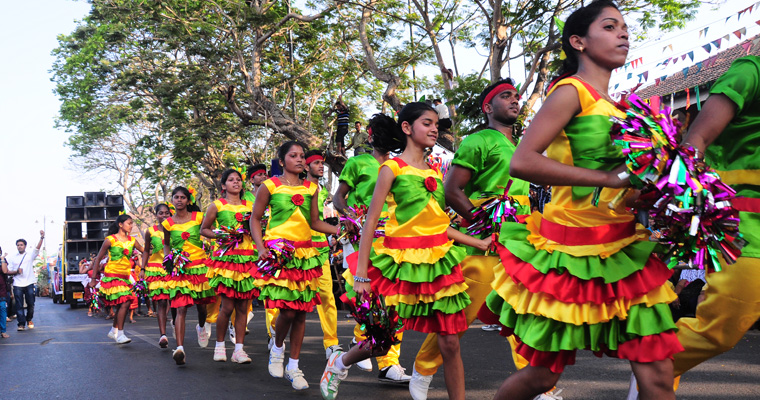Inside Goa’s Indo-Portuguese comeback
An Indo-Portuguese house that would once have been demolished now sells for 30 million rupees. Football crazy Goans, glued to the TV screen at the Down The Road pub in Panjim, roar in support of Portugal. Seventy singers and musicians queue up to have their moments in the limelight at Vem Cantar, the annual Portuguese singing contest, attended by a thousand strong crowd at Kala Academy.
Fifty-one years after India took over this tiny coastal Portuguese colony on 19th December 1961, Goa’s extraordinary blend of East and West, its Indo-Portuguese culture, is seeing an unmistakable revival.
How Goa’s unique Portuguese-influenced variant is at last coming into its own half a century after liberation is a story of pride, reconciliation and unbridled assertion of identity.
Many facets of Goan life― food, music, dance, football, language, architecture, etc―are imbued with this spirit. New housing projects are flaunted as being ‘Portuguese villas’. Goan youth sport Portugal stickers on their cars, fancy Portuguese name plates adorn house gates (even if the owners are settlers from Delhi), European-inspired ballroom dance classes are booming business and many starred hotels have signature Indo-Portuguese restaurants. New job advertisements now appear asking for Portuguese speaking candidates for outsourcing jobs in Goa. The Indo-Portuguese craze is clearly driven by market forces, including the State Tourism Department, that see Goa as a special brand with its 451 years of cultural fusion.
To be sure, not everybody in Goa loves Portugal and all things Portuguese. A certain amount of resentment towards past colonial impositions persists. The religion and identity of Catholic Goans are clearly more closely aligned with Portugal than that of Hindus. Though many Hindus, especially those in the upper classes, enthusiastically embrace Goa’s Portuguese heritage.
It is undeniable that the uniquely evolved Indo-Portuguese culture in Goa serves the market needs of a number of sectors, most notably tourism and real estate. But what is perhaps more interesting is how so many Goans – whose ancestors endured centuries of Portuguese colonialism that ranged from the benign to the brutal – now look at Portugal without any rancor, cheerfully embracing it as a natural part of Goa’s own hybrid identity.
Vem Cantar, an annual Portuguese singing competition started out as a small event conducted by the Heritage Cell of Rosary College, Navelim in 1998. Fundação Oriente, a Panjim-based Portuguese cultural foundation, joined hands four years later, and the contest has now gained popularity, attracting hundreds of listeners, musicians, singers, teachers and parents. Twenty-three groups and 37 solo singers, accompanied by musicians, took part in the contest in 2012.
The Portuguese language that sought domination in colonial times was quelled after liberation, but now finds new voice in Goa’s music loving youngsters.
“We have been improving the quality over the years,” says Dr Eduardo Kol Carvalho, the Director of Fundação Oriente, which opened its office in Goa in 1995.
Sonia Sirsat, an accomplished fado singer, herself was ‘discovered’ at a Vem Cantar contest where she won the first place in the group category. She now conducts workshops at the centre.
“With her talent, she would have become a good singer anyway,” says Carvalho. “But Vem Cantar launched her career. In recent years Clube Nacional and other institutions often invite the winners of this contest to perform at their events. Prominent singers also perform at the monthly Noite de Fado at the Cidade de Goa hotel, as well as the annual Monte Festival at Old Goa.”
[tok id=797375b970e944711271182f1a7a7c3d partner=9385]
The music workshop introduces the latest hits by bands in Portugal and Brazil, catchy fast-paced songs that have captivated the young participants, who also learn older nostalgic songs from Goa’s Portuguese past.
Lack of fluency in the Portuguese language does not deter the Vem Cantar teenagers from belting out these hit songs, combining the music with neatly choreographed dances. “We now sing songs like Oculos de Sol, Cantiga Da Rua and Cabecinha No Ombro at our parties, along with Konkani and English songs,” says Mia Marie (14), a student of Fatima Convent, Margao.
The Portuguese colonial regime sought to impose its language in all areas of Goan life during their four and half centuries of rule, often repressing the local Konkani language by draconian edicts. After the end of Portuguese rule in 1961, the Portuguese language underwent a subdued phase in Goan society. Most of the generation born in the 1960s were not taught Portuguese, even by Portuguese-speaking parents, as English was seen as the new language for education and employment.
But Carvalho sees a surge in Portuguese being studied in Goa in the last decade.
“In 1999, the Fundação supported Portuguese teachers covering 240 students. In this academic year 2012-13, the number has gone to 788 students. There are also other schools that are not supported by us, so the number of students of Portuguese could be much more.”
Carvalho admits that most of the interest in Portuguese language comes from Goan Catholic families, though many of the students who win prizes for best marks in Portuguese also come from non-Christian families.
Goa University has a Portuguese Department headed by Delfim Correia da Silva, who also heads the Instituto Camões, an institution affiliated to the Ministry of Foreign Affairs of Portugal.
Why does the passion for Indo-Portuguese culture run so strong in Goa?
“If you ask anyone here, who are you, they proudly say – we are Goan,” remarks Carvalho. “What distinguishes Goans from Maharashtrians or other states is the mixture of cultures from the East and the West. It is not only Portuguese heritage. Goa was a trading port, a hub for cultures from Africa, China, Japan, Arabia as well as other parts of India, and it was also influenced by people from Europe – Portuguese, Spanish, Italian…Remember, Portugal itself is a composite culture.”
From 1961 to 1974, there were no diplomatic relations between Portugal and India. It was only after the Carnation Revolution of 1974 that Portugal recognized Indian sovereignty over Goa, Daman and Diu. Portugal continues to give the citizens of Portuguese India automatic citizenship.
It has been recently reported that around 3 Goans gain Portuguese citizenship every day, by virtue of holding a Portuguese passport that is largely seen as a ticket to Europe rather than a love for the Portuguese country or culture.
“Most applicants seek the Portuguese passport for economic rather than cultural reasons,” avers Carvalho. “It depends on the family background. If the applicants come from upper class families that are familiar with the Portuguese language and culture, there are more chances that they may settle in Portugal.”
Now more than ever, Indo-Portuguese architecture is celebrated in Goa, with prices of heritage houses touching crores of rupees. However, prominent architect Gerard da Cunha warns against trivialising the past through cut-and-paste architecture that seeks to mimic the colonial legacy.
“This is not the time for superficial borrowing of images and elements,” says da Cunha. The Indo-Portuguese house is an exciting, experimental and wonderfully evolved aesthetic. We have to take the essence of this Indo-Portuguese house forward.”
Football, another strong Goan passion, dates back to the 1880s, when the sport was formally introduced here by Fr William Robert Lyon. And, although Fr Lyon was an Irishman who came to Goa from Udipi in neighbouring Karnataka, it is not Ireland that’s credited for Goa’s love for the sport. It is Portugal, whose government helped propagate the game in the nearly eight decades between 1883 and 1961.
That football got top priority over several other matters of state from the Portuguese was evident in the presence of the Governor General at the first competitive match played in 1900 in Panjim, says retired bureaucrat and a historian by hobby, Percival Noronha. “The Governor General attending non-official functions in public was a rarity those days,” Percival adds.
The Goa Football Association, which still governs all matters football in the state, was formed in the Portuguese era barely two years before Goa gained freedom from colonial rule in 1961.
The Catholic Church, powerful in the matters of state and a close collaborator of the Portuguese government, also played a strong role in popularising the sport.
Football’s popularity among Goans has only soared with time. And, when it’s football on the big stage where there’s no Indian team to cheer, it’s the Portuguese side that most Goans root for, be it the European Championship or the World Cup.
Apart from the football pitch, it’s the kitchen in almost every Goan home, where the Portuguese influence is most visible.
Pork sorpotel and vindaloo, at least half-a-dozen spicy beef recipes, fish caldinho and a number of vegetarian dishes in Hindu Goan homes, speak volumes about an entirely unique culinary genre – Indo-Portuguese cuisine. A number of curries made by the indigenous Goan population got transformed with the addition of certain spices introduced by the Portuguese.
The chilly, writes Dr Fatima de Silva Gracias in her book Journey of Goan Food, completely changed the culinary habits of Goa. “Unknown to many, chillies were alien to the Asian continent until the Portuguese introduced it here in Goa,” Dr Gracias said, adding that there’s no dish in the Goan’s daily diet that’s made without it, especially the red, dry chilly.
A Goan cuisine revival is evident these days throughout the state. Recently, the Park Hyatt hotel in South Goa hosted a food event featuring modern variations of traditional Indo-Portuguese cuisine. Restaurants like Mum’s Kitchen, Nostalgia and Martin’s Corner are all at the forefront of this culinary revival.
Linguists agree that the Portuguese language has strongly influenced the Konkani language. Words like lugar (space), cuidado (care), mez (table) and pequeno (child) are deeply embedded in the Goan Konkani psyche. In many houses, the Portuguese language penetrated deeply, and has thrived down the generations, though it is now an archaic spoken form as compared to modern spoken Portuguese in Europe.
“Portuguese is my mother-tongue. It’s a fact that cannot be changed,” says Panjim-based Right to Information activist Rui Fereira.
Freedom fighter and a strong critic of the Portuguese, Naguesh Karmali, acknowledges the significant colonial influences, including cuisine and education.
“These are accidents of history. Our opposition is not to these influences per-se, but to their glorification. More importantly, my distaste for the Portuguese stems from the repression they unleashed and the suppression of an individual’s freedom during their rule,” Karmali said.
Konkani writer Damodar Mauzo cautions against calling it an Indo-Portuguese culture rather than a Goan culture that happened to take on foreign influences. “We in Goa were isolated from the rest of India for many centuries, and we adapted our cuisine and other facets of our culture by absorbing the Portuguese influences.”
Does an affinity for the Portuguese language and culture imply an anti-national streak? “Of course not. Portuguese is a beautiful language, even more charming than English. It is wonderful to study it as a foreign language.” Does the sentiment prevail broadly across the Hindu community in Goa? “Those who reflect on culture, will not find anything negative in the Indo-Portuguese culture. It is only the ultra nationalists who raise their protests every time the name Portugal comes up,” remarks Mauzo.
The rest appear more than happy to be part of that rich heritage.
.
.
.









